CNN迎来了新的变革:isotropic architecture
 点蓝色字关注“机器学习算法工程师”
点蓝色字关注“机器学习算法工程师”
设为星标,干货直达!
前段时间,一篇匿名论文Patches Are All You Need? 火了,这篇文章提出用基于卷积的block来替换ViT中的transformer block,这样就变成了基于patch的卷积网络ConvMixer,它和ViT模型一样都属于同质架构(isotropic architecture):模型主体是由相同的blocks重复串联而成。一旦block固定,基于同质架构的模型只需要用特征大小(即patch embedding的维度)和网络深度(即blocks数量)两个参数定义。其实谷歌在提出ViT之后,在后续的工作MLP-Mixer中提出了用基于2个MLP的block来替换ViT中的transformer block,MetaAI同期也提出了训练更高效的版本ResMLP,它们都和ViT一样属于同质架构,区别就在于block不一样。虽然从网络设计上来看基于同质架构的模型更简单,但是主流的CNN模型往往不是同质架构,而是一种金字塔架构(pyramidal architecture),对比如下所示,这种金字塔架构包含几个不同的stage,各个stage之间是一个下采样操作比如stride=2的max pooling或者conv。CNN常用的金字塔架构好处在于下采样可以较快地增大感受野,而且下采样也降低了特征图大小,从而计算上更高效。而ConvMixer打破了这种经典的金字塔架构设计,不过这并不是最早的工作,比如谷歌在2019年就提出了Isotropic MobileNetv3,但这个工作并未受到较大的关注,另外MetaAI在ResMLP论文中也探讨了用卷积来替换MLP。而MeatAI在最新的论文Augmenting Convolutional networks with attention-based aggregation中设计了一种性能更优的PatchConvNet,相比ConvMixer,PatchConvNet在速度和准确度上都更好,而且PatchConvNet也在密集任务如检测和分割上表现优异。本文将简单地介绍这些相关的工作以及它们的区别和联系。

MLP-Mixer和ResMLP
继ViT之后,谷歌又提出了只包含MLP架构的MLP-Mixer,如下图所示。相比ViT,MLP-Mixer也是先经过patch embedding layer得到patch tokens,然后送入N个相同的blocks,区别就在于这里的block不再是transformer block,而是包含两个MLP的Mixer Layer。这里的第一个MLP用于实现token mixing(对特征矩阵转置),这个就相当于transformer block中的self-attention模块,用于建立tokens间的信息交互,而第二个MLP用于实现channel mixing,这个和transformer block中FFP模块完全一致,用于建立每个token的channels间的信息交互。MLP-Mixer和ViT一样,都是全局建模,而且也都是同质架构。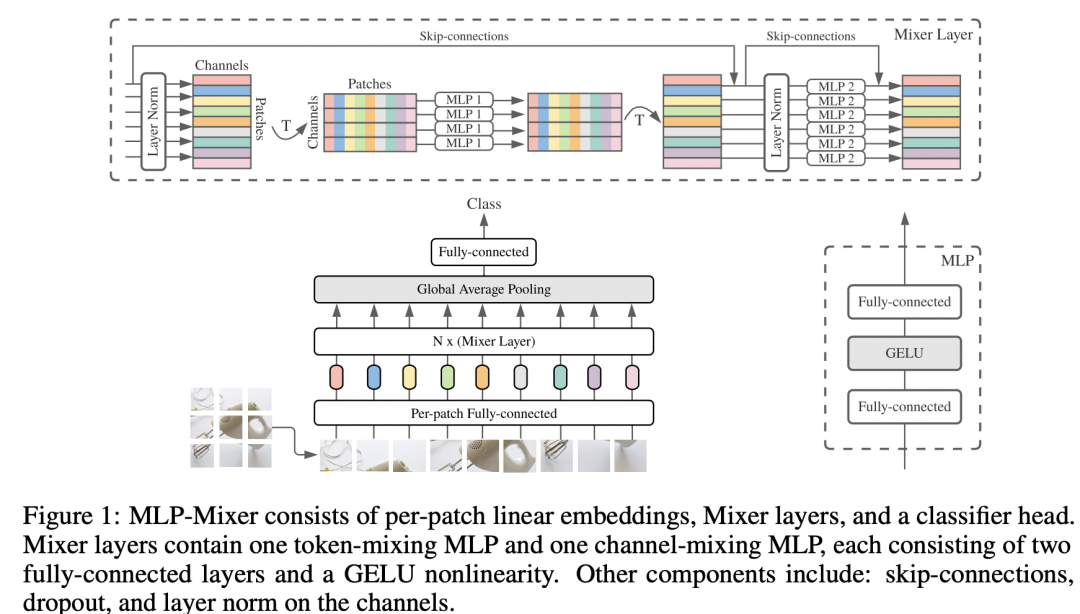 虽然谷歌在论文中通过实验证明了MLP-Mixer可以达到和ViT类似的效果,但是比较依赖大规模数据的预训练。相较之下,MeatAI同期的工作ResMLP只使用ImageNet-1K数据集,和DeiT一样,它是通过采用heavy的数据增强策略来消除对大规模训练数据的依赖。在架构上,ResMLP基本和MLP-Mixer一样,一个区别是ResMLP block中用于tokens间交互的模块只用了一个fc层,而不是包含2个fc层的MLP,另外ResMLP采用了一种更简单的norm layer来替换LayerNorm。
虽然谷歌在论文中通过实验证明了MLP-Mixer可以达到和ViT类似的效果,但是比较依赖大规模数据的预训练。相较之下,MeatAI同期的工作ResMLP只使用ImageNet-1K数据集,和DeiT一样,它是通过采用heavy的数据增强策略来消除对大规模训练数据的依赖。在架构上,ResMLP基本和MLP-Mixer一样,一个区别是ResMLP block中用于tokens间交互的模块只用了一个fc层,而不是包含2个fc层的MLP,另外ResMLP采用了一种更简单的norm layer来替换LayerNorm。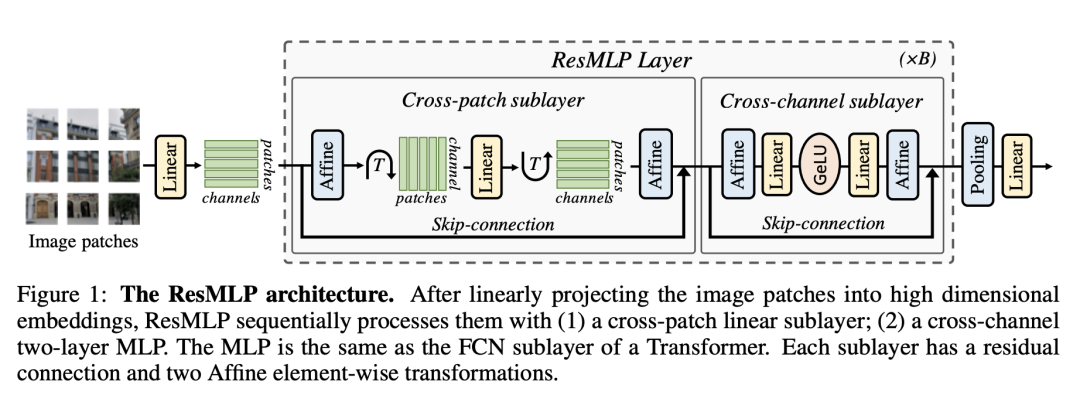 ResMLP的PyTorch代码实现如下所示,作为一种同质架构,整体的代码实现是比较简洁的。
ResMLP的PyTorch代码实现如下所示,作为一种同质架构,整体的代码实现是比较简洁的。
# No norm layer
class Affine(nn.Module):
def __init__(self, dim):
super().__init__()
self.alpha = nn.Parameter(torch.ones(dim))
self.beta = nn.Parameter(torch.zeros(dim))
def forward(self, x):
return self.alpha * x + self.beta
# MLP on channels
class Mlp(nn.Module):
def __init__(self, dim):
super().__init__()
self.fc1 = nn.Linear(dim, 4 * dim)
self.act = nn.GELU()
self.fc2 = nn.Linear(4 * dim, dim)
def forward(self, x):
x = self.fc1(x)
x = self.act(x)
x = self.fc2(x)
return x
# ResMLP blocks: a linear between patches + a MLP to process them independently
class ResMLP_BLocks(nn.Module):
def __init__(self, nb_patches ,dim, layerscale_init):
super().__init__()
self.affine_1 = Affine(dim)
self.affine_2 = Affine(dim)
self.linear_patches = nn.Linear(nb_patches, nb_patches) #Linear layer on patches
self.mlp_channels = Mlp(dim) #MLP on channels
self.layerscale_1 = nn.Parameter(layerscale_init * torch.ones((dim))) #LayerScale
self.layerscale_2 = nn.Parameter(layerscale_init * torch.ones((dim))) # parameters
def forward(self, x):
res_1 = self.linear_patches(self.affine_1(x).transpose(1,2)).transpose(1,2))
x = x + self.layerscale_1 * res_1
res_2 = self.mlp_channels(self.affine_2(x))
x = x + self.layerscale_2 * res_2
return x
# ResMLP model: Stacking the full network
class ResMLP_models(nn.Module):
def __init__(self, dim, depth, nb_patches, layerscale_init, num_classes):
super().__init__()
self.patch_projector = Patch_projector()
self.blocks = nn.ModuleList([
ResMLP_BLocks(nb_patches ,dim, layerscale_init)
for i in range(depth)])
self.affine = Affine(dim)
self.linear_classifier = nn.Linear(dim, num_classes)
def forward(self, x):
B, C, H, W = x.shape
x = self.patch_projector(x)
for blk in self.blocks:
x = blk(x)
x = self.affine(x)
x = x.mean(dim=1).reshape(B,-1) #average pooling
return self.linear_classifier(x)
既然MLP都有效,那么一个问题是如果采用基于卷积的block,这种同质架构还有效吗?其实,谷歌在MLP-Mixer论文中也讨论了MLP-Mixer和CNN的联系:用于channel mixing的MLP可以用1x1卷积实现,而token mixing MLP可以用一个kernel size为image size的depth-wise conv来实现(这里各个channel的参数是共享的)。因而MLP-Mixer其实也可以看成一种特殊的CNN架构。虽然1x1卷积是比较常见的,但是kernel size等于image size的卷积并不是一种常规的卷积(虽然对特征矩阵转置后,token-mixing MLP实际上也可以1x1卷积实现,但这个也不是CNN的常规操作),那么问题是能否用常规的卷积如3x3卷积来实现token mixing MLP,这个问题可以在ResMLP论文中找到答案。ResMLP只用了一个FC层来实现token mixing,其weights可视化如下图所示,可以看到在前面的layers其表现出局部性,虽然理论上token mixing是可以实现全局感受野的,但是它实际的行为却和卷积比较类似,这提示可以用卷积来替换FC。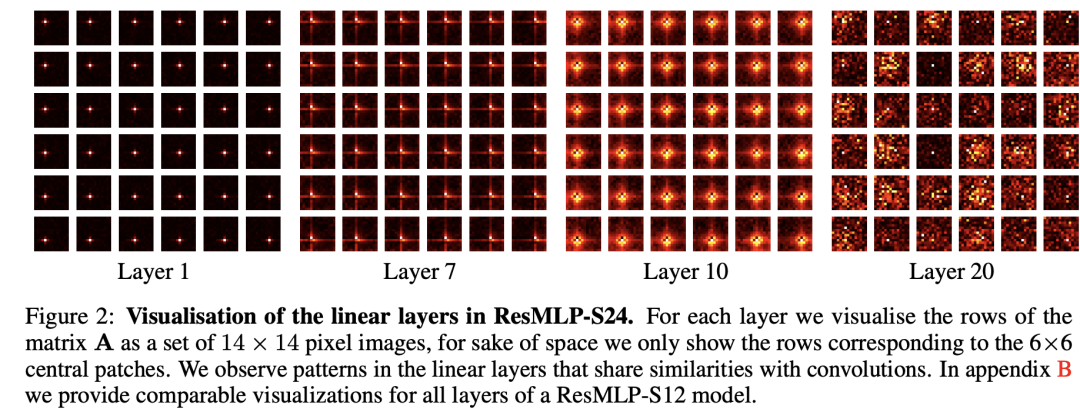 论文尝试了用3x3 conv,3x3 depth-wise conv和3x3 depth-separable conv来替代这个FC层,发现模型效果并没有太多变化,比如采用轻量级的3x3 depth-wise conv,其参数量和FLOPs都降低了,但是模型效果只下降了0.3(76.3 vs 76.6)。这样替换之后,网络就变成了一个纯粹基于卷积的同质架构,这与之前常用的金字塔架构相区别:
论文尝试了用3x3 conv,3x3 depth-wise conv和3x3 depth-separable conv来替代这个FC层,发现模型效果并没有太多变化,比如采用轻量级的3x3 depth-wise conv,其参数量和FLOPs都降低了,但是模型效果只下降了0.3(76.3 vs 76.6)。这样替换之后,网络就变成了一个纯粹基于卷积的同质架构,这与之前常用的金字塔架构相区别:
This suggests that convolutions on low-resolution feature maps at all layers is an interesting alternative to the common pyramidal design of convnets, where early layers operate at higher resolution and smaller feature dimension.
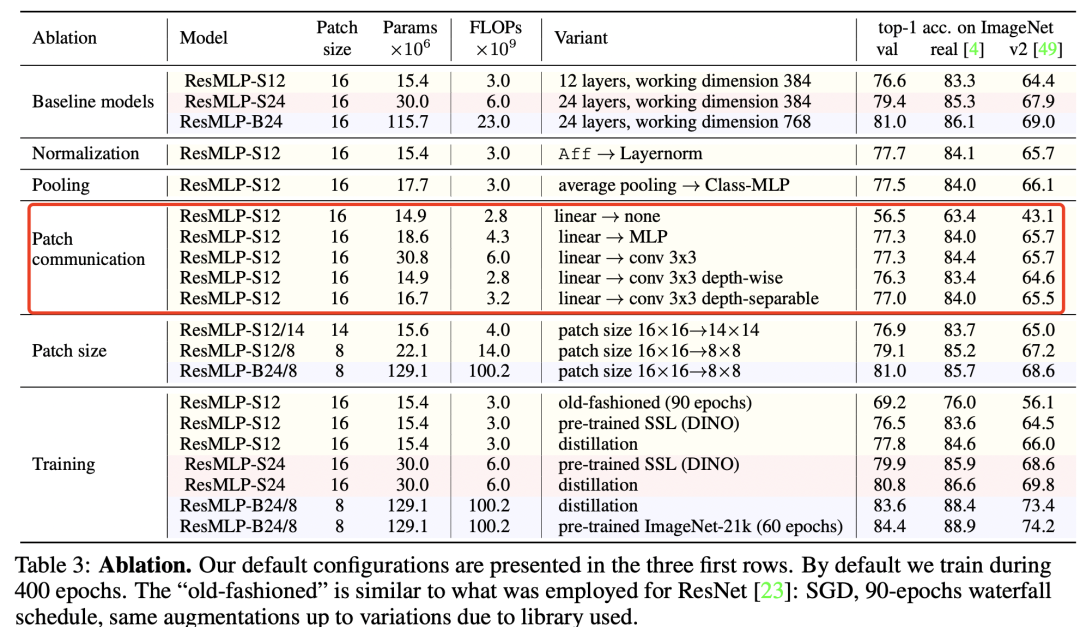 这里要讨论的一点是,无论是self-attention还是MLP,它们在理论上都可以实现全局建模,但是卷积没有这种优势,因为它只能实现局部建模,不过通过堆积大量的卷积层,感受野最终也可以达到全局,而且卷积的这种inductive bias对CV任务也有天然优势。而在架构方面,self-attention和卷积都能处理变输入,而MLP(token mixing)只能处理固定输入。
这里要讨论的一点是,无论是self-attention还是MLP,它们在理论上都可以实现全局建模,但是卷积没有这种优势,因为它只能实现局部建模,不过通过堆积大量的卷积层,感受野最终也可以达到全局,而且卷积的这种inductive bias对CV任务也有天然优势。而在架构方面,self-attention和卷积都能处理变输入,而MLP(token mixing)只能处理固定输入。
ConvMixer
ConvMixer这篇工作motivation是来自于谷歌的MLP-Mixer,其设计思路是:用kernel size比较大的conv实现token mixing,而用pointwise conv(即1x1 conv)来实现channel mixing。ConvMixer的整体架构如下所示:
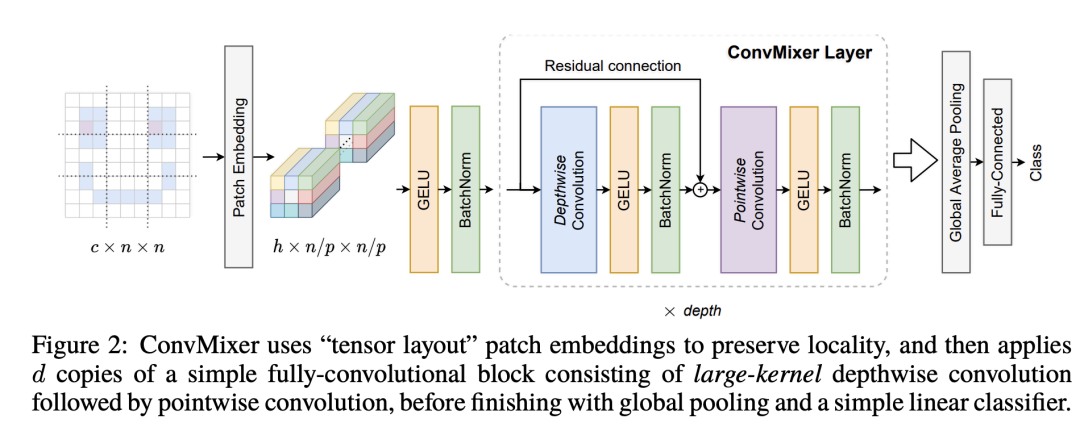 这种设计和ResMLP的conv版本区别主要有两点:一是ConvMixer采用kernel size较大(eg. 9x9)的depth-wise conv来实现token mixing;二是ConvMixer只用了一个1x1 conv来实现channel mixing,而ResMLP是用一个MLP,这等价于2个1x1 conv。ConvMixer采用较大的kernel size是想实现较大的感受野,但其实ResMLP却已经证明3x3 conv也是能够实现好的性能。ConvMixer的代码实现如下所示:
这种设计和ResMLP的conv版本区别主要有两点:一是ConvMixer采用kernel size较大(eg. 9x9)的depth-wise conv来实现token mixing;二是ConvMixer只用了一个1x1 conv来实现channel mixing,而ResMLP是用一个MLP,这等价于2个1x1 conv。ConvMixer采用较大的kernel size是想实现较大的感受野,但其实ResMLP却已经证明3x3 conv也是能够实现好的性能。ConvMixer的代码实现如下所示:
class Residual(nn.Module):
def __init__(self, fn):
super().__init__()
self.fn = fn
def forward(self, x):
return self.fn(x) + x
def ConvMixer(dim, depth, kernel_size=9, patch_size=7, n_classes=1000):
return nn.Sequential(
nn.Conv2d(3, dim, kernel_size=patch_size, stride=patch_size),
nn.GELU(),
nn.BatchNorm2d(dim),
*[nn.Sequential(
Residual(nn.Sequential(
nn.Conv2d(dim, dim, kernel_size, groups=dim, padding="same"),
nn.GELU(),
nn.BatchNorm2d(dim)
)),
nn.Conv2d(dim, dim, kernel_size=1),
nn.GELU(),
nn.BatchNorm2d(dim)
) for i in range(depth)],
nn.AdaptiveAvgPool2d((1,1)),
nn.Flatten(),
nn.Linear(dim, n_classes)
)
虽然ConvMixer在同样的参数量下效果可以达到或者超过ResNet,ResMLP和DeiT,但是由于使用较大的kernel size,而且ConvMixer也采用了较小的patch size(7x7,这样特征图较大),这导致其计算量较大,速度较慢。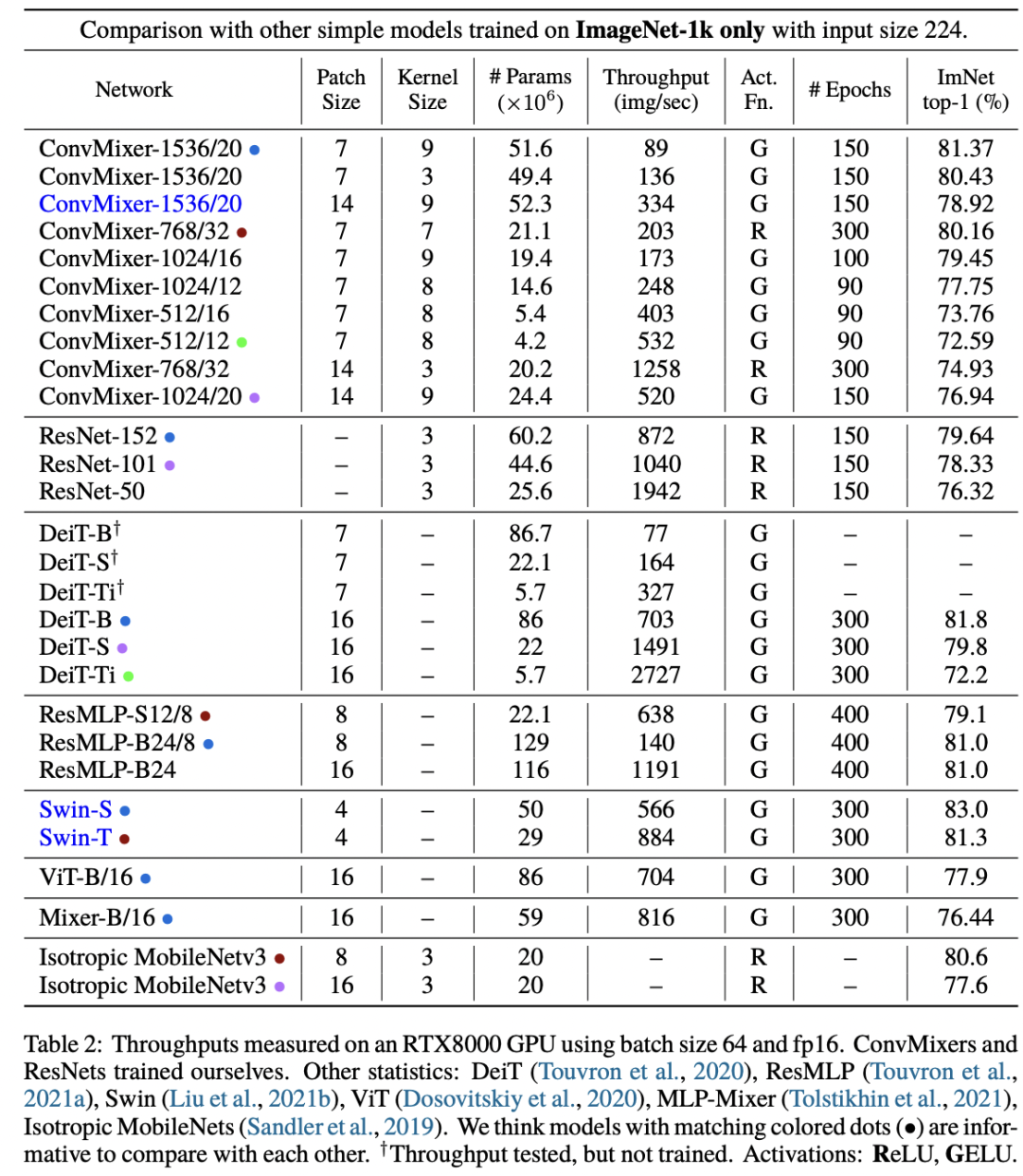 ConvMixer和ViT,MLP-Mixer的一个共同点就是它们都是基于patch的模型,所以论文说:patches are all you need,但其实它们更大的一个相似点是:它们都属于同质架构。
ConvMixer和ViT,MLP-Mixer的一个共同点就是它们都是基于patch的模型,所以论文说:patches are all you need,但其实它们更大的一个相似点是:它们都属于同质架构。
PatchConvNet
PatchConvNet是MetaAI在最近的论文Augmenting Convolutional networks with attention-based aggregation提出的,虽然这个论文的主题是用attention-based aggregation(即attention-based pooling)来替换CNN中常用的global average pooling从而增强模型性能,但论文采用的是一种基于patch的同质CNN架构。 相比ConvMixer,PatchConvNet采用了convolutional stem来提取patch embedding,而不是采用一个简单linear projection,这个问题在论文Early Convolutions Help Transformers See Better被详细地研究过:ViT原来地linear projection等价于一个stride=p且kernel_size=p的conv,如果把它转换成几个堆叠的stride=2的3*3 conv,无论是在模型效果上,还是在训练稳定性以及收敛速度都更好。具体地,PatchConvNet采用的patch size为16x16,这样把它转换为4个stride=2的3x3卷积,代码实现如下所示(这里每经过一个conv,channels也double,最终达到patch embedding的维度大小):
相比ConvMixer,PatchConvNet采用了convolutional stem来提取patch embedding,而不是采用一个简单linear projection,这个问题在论文Early Convolutions Help Transformers See Better被详细地研究过:ViT原来地linear projection等价于一个stride=p且kernel_size=p的conv,如果把它转换成几个堆叠的stride=2的3*3 conv,无论是在模型效果上,还是在训练稳定性以及收敛速度都更好。具体地,PatchConvNet采用的patch size为16x16,这样把它转换为4个stride=2的3x3卷积,代码实现如下所示(这里每经过一个conv,channels也double,最终达到patch embedding的维度大小):
def conv3x3(in_planes, out_planes, stride=1):
"""3x3 convolution with padding"""
return torch.nn.Sequential(
nn.Conv2d(
in_planes, out_planes, kernel_size=3, stride=stride, padding=1, bias=False
),
)
class ConvStem(nn.Module):
""" Image to Patch Embedding
"""
def __init__(self, img_size=224, patch_size=16, in_chans=3, embed_dim=768):
super().__init__()
img_size = to_2tuple(img_size)
patch_size = to_2tuple(patch_size)
num_patches = (img_size[1] // patch_size[1]) * (img_size[0] // patch_size[0])
self.img_size = img_size
self.patch_size = patch_size
self.num_patches = num_patches
self.proj = torch.nn.Sequential(
conv3x3(3, embed_dim // 8, 2),
nn.GELU(),
conv3x3(embed_dim // 8, embed_dim // 4, 2),
nn.GELU(),
conv3x3(embed_dim // 4, embed_dim // 2, 2),
nn.GELU(),
conv3x3(embed_dim // 2, embed_dim, 2),
)
def forward(self, x, padding_size=None):
B, C, H, W = x.shape
x = self.proj(x).flatten(2).transpose(1, 2)
return x
在block设计方面,PatchConvNet采用了基于SE的residual block(1x1 conv -> 3x3 depth-wise conv -> SE -> 1x1 conv),这个是CNN中最常用的结构。注意这里采用了pre-norm,只在block的开始采用norm layer,可以使用BatchNorm或者LayerNorm,虽然BatchNorm能比LayerNorm实现更好的性能,但BatchNorm比较依赖batch size,所以论文默认采用LayerNorm。具体的代码实现如下(这里采用了CaiT中提出的LayerScale):
class Conv_blocks_se(nn.Module):
def __init__(self, dim):
super().__init__()
self.qkv_pos = nn.Sequential(
nn.Conv2d(dim, dim, kernel_size = 1),
nn.GELU(),
nn.Conv2d(dim, dim, groups = dim, kernel_size = 3, padding = 1, stride = 1, bias = True),
nn.GELU(),
SqueezeExcite(dim, rd_ratio=0.25),
nn.Conv2d(dim, dim, kernel_size=1),
)
def forward(self, x):
B, N, C = x.shape
H = W = int(N**0.5)
x = x.transpose(-1,-2)
x = x.reshape(B,C,H,W)
x = self.qkv_pos(x)
x = x.reshape(B,C,N)
x = x.transpose(-1,-2)
return x
class Layer_scale_init_Block(nn.Module):
def __init__(self, dim,drop_path=0., act_layer=nn.GELU, norm_layer=nn.LayerNorm,
Attention_block=Conv_blocks_se, init_values=1e-4):
super().__init__()
self.norm1 = norm_layer(dim)
self.attn = Attention_block(dim)
self.drop_path = DropPath(drop_path) if drop_path > 0. else nn.Identity()
self.gamma_1 = nn.Parameter(init_values * torch.ones((dim)),requires_grad=True)
def forward(self, x):
return x + self.drop_path(self.gamma_1 * self.attn(self.norm1(x)))
最后一点是PatchConvNet采用了attention-based pooling而不是global average pooling,后者是CNN最常采用的,即简单地取对所有patches的特征求平均,而attention-based pooling是基于attention的加权平均。具体地,增加一个可训练的class token,先对所有的patches做attention得到加权平均,然后加上class token送入一个FFN。具体的代码实现如下所示:
class Learned_Aggregation_Layer(nn.Module):
def __init__(self, dim, num_heads=1, qkv_bias=False, qk_scale=None, attn_drop=0., proj_drop=0.):
super().__init__()
self.num_heads = num_heads
head_dim = dim // num_heads
self.scale = qk_scale or head_dim ** -0.5
self.q = nn.Linear(dim, dim, bias=qkv_bias)
self.k = nn.Linear(dim, dim, bias=qkv_bias)
self.v = nn.Linear(dim, dim, bias=qkv_bias)
self.attn_drop = nn.Dropout(attn_drop)
self.proj = nn.Linear(dim, dim)
self.proj_drop = nn.Dropout(proj_drop)
def forward(self, x ):
B, N, C = x.shape
q = self.q(x[:,0]).unsqueeze(1).reshape(B, 1, self.num_heads, C // self.num_heads).permute(0, 2, 1, 3)
k = self.k(x).reshape(B, N, self.num_heads, C // self.num_heads).permute(0, 2, 1, 3)
q = q * self.scale
v = self.v(x).reshape(B, N, self.num_heads, C // self.num_heads).permute(0, 2, 1, 3)
attn = (q @ k.transpose(-2, -1))
attn = attn.softmax(dim=-1)
attn = self.attn_drop(attn)
x_cls = (attn @ v).transpose(1, 2).reshape(B, 1, C)
x_cls = self.proj(x_cls)
x_cls = self.proj_drop(x_cls)
return x_cls
class Layer_scale_init_Block_only_token(nn.Module):
def __init__(self, dim, num_heads, mlp_ratio=4., qkv_bias=False, qk_scale=None, drop=0., attn_drop=0.,
drop_path=0., act_layer=nn.GELU, norm_layer=nn.LayerNorm, Attention_block = Learned_Aggregation_Layer, Mlp_block=Mlp,
init_values=1e-4):
super().__init__()
self.norm1 = norm_layer(dim)
self.attn = Attention_block(
dim, num_heads=num_heads, qkv_bias=qkv_bias, qk_scale=qk_scale, attn_drop=attn_drop, proj_drop=drop)
# NOTE: drop path for stochastic depth, we shall see if this is better than dropout here
self.drop_path = DropPath(drop_path) if drop_path > 0. else nn.Identity()
self.norm2 = norm_layer(dim)
mlp_hidden_dim = int(dim * mlp_ratio)
self.mlp = Mlp_block(in_features=dim, hidden_features=mlp_hidden_dim, act_layer=act_layer, drop=drop)
self.gamma_1 = nn.Parameter(init_values * torch.ones((dim)),requires_grad=True)
self.gamma_2 = nn.Parameter(init_values * torch.ones((dim)),requires_grad=True)
def forward(self, x, x_cls):
u = torch.cat((x_cls,x),dim=1)
x_cls = x_cls + self.drop_path(self.gamma_1 * self.attn(self.norm1(u)))
x_cls = x_cls + self.drop_path(self.gamma_2 * self.mlp(self.norm2(x_cls)))
return
从实现上来看,其实attention-based pooling就是一个简化的transformer block,这里在做attention时query只有class token,而且attention head设置为1,这个设计也是在CaiT中提出的。attention-based pooling的好处是直接用attention map就可以可视化分类模型的决策,而CNN往往需要一些复杂的方法如CAM来做可视化,而ViT由于涉及不同的layers和heads也需要特殊处理attention map。这里默认采用一个class token,也可以每个类都定义一个单独的class token,这样可以得到每个类的attention map,不过这样计算量也变大了。 PatchConvNet由于是同质架构,只需要两个参数就可以定义:特征维度大小和网络深度(blocks数量)。论文共设置3种不同的特征大小:384,768和1024,分别用S,B和L表示,比如S60模型就表示特征大小是384,而blocks数量为60,这个模型在参数量和FLOPs上和ResNet50相当。PatchConvNet由于是同质架构,所以在推理阶段,其使用的memory量是恒定的(不考虑前后处理,即conv stem和attention-based pooling),另外PatchConvNet的一个特性它的peak memory是较低的,而且和图像大小基本上是线性关系,如下图所示,而ViT这样的模型其peak memory与图像大小的平方成正比,当输入图像增大时,peak memory增长较快,这对于输入较大的分割和检测任务是非常不友好的。
PatchConvNet由于是同质架构,只需要两个参数就可以定义:特征维度大小和网络深度(blocks数量)。论文共设置3种不同的特征大小:384,768和1024,分别用S,B和L表示,比如S60模型就表示特征大小是384,而blocks数量为60,这个模型在参数量和FLOPs上和ResNet50相当。PatchConvNet由于是同质架构,所以在推理阶段,其使用的memory量是恒定的(不考虑前后处理,即conv stem和attention-based pooling),另外PatchConvNet的一个特性它的peak memory是较低的,而且和图像大小基本上是线性关系,如下图所示,而ViT这样的模型其peak memory与图像大小的平方成正比,当输入图像增大时,peak memory增长较快,这对于输入较大的分割和检测任务是非常不友好的。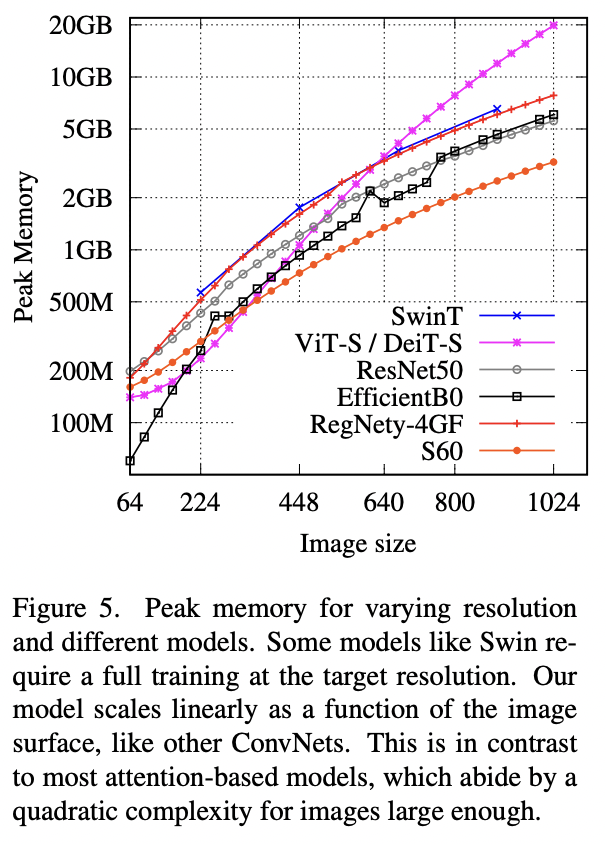 PatchConvNet在ImageNet1K数据集上表现如下表所示,其在准确度和计算量上均表现较好。比如S60模型,其FLOPs和throughout和Swin-T类似,但效果比Swin-T更好,而且peak memory远低于Swin-T(不过PatchConvNet训练的epoch是400,而Swin训练的epoch是300,两者的训练策略基本一致)。
PatchConvNet在ImageNet1K数据集上表现如下表所示,其在准确度和计算量上均表现较好。比如S60模型,其FLOPs和throughout和Swin-T类似,但效果比Swin-T更好,而且peak memory远低于Swin-T(不过PatchConvNet训练的epoch是400,而Swin训练的epoch是300,两者的训练策略基本一致)。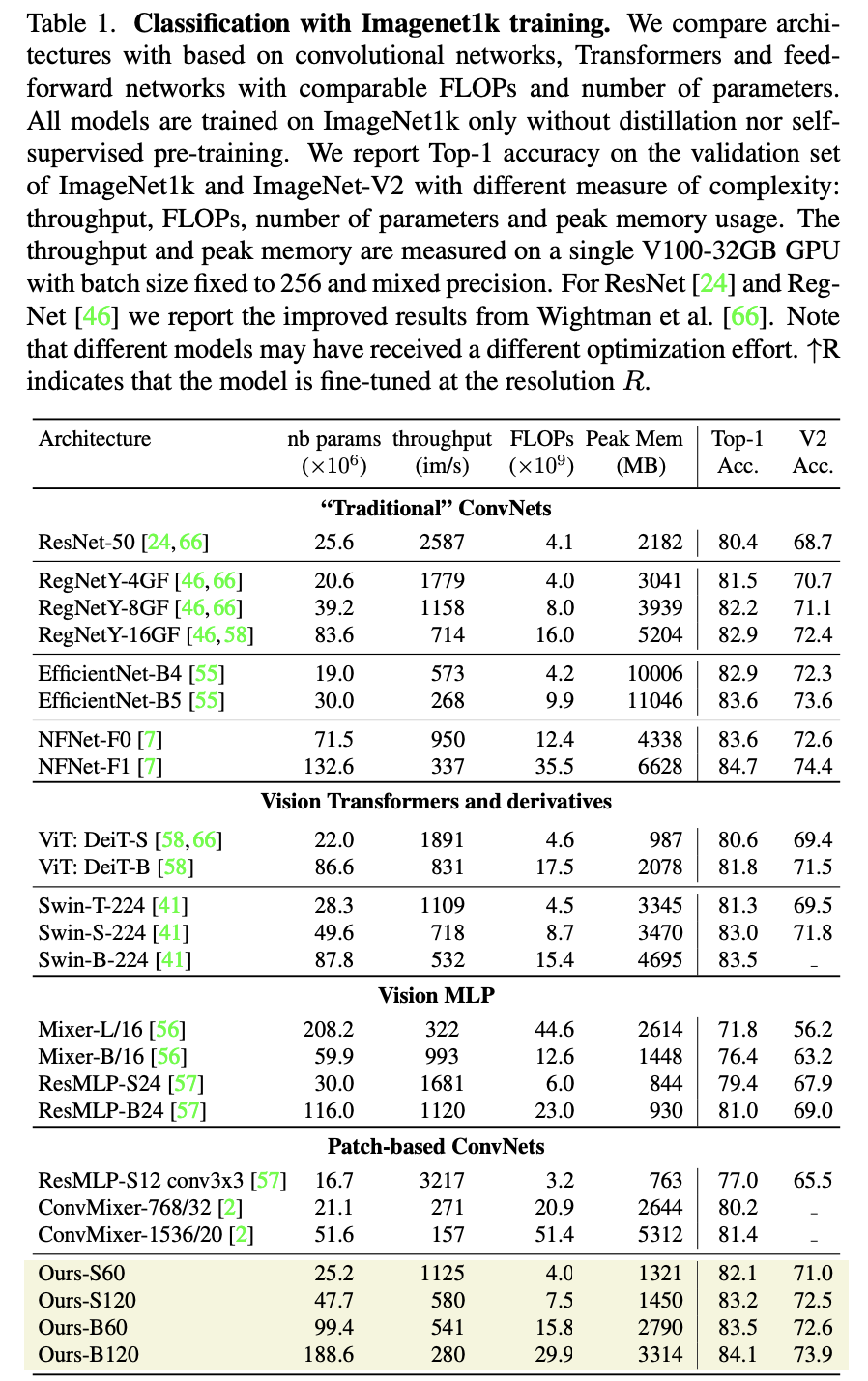 PatchConvNet在分割和检测任务上也表现优异,如下表所示。由于分割和检测往往需要多尺度的输入,而PatchConvNet只输出1/16大小的特征,这里采用XciT的解决方案,即对PatchConvNet的中间输出通过上采样(stride=2的2x2反卷积)或者下采样(stride=2的2x2 max pooling)来得到不同尺度的特征。
PatchConvNet在分割和检测任务上也表现优异,如下表所示。由于分割和检测往往需要多尺度的输入,而PatchConvNet只输出1/16大小的特征,这里采用XciT的解决方案,即对PatchConvNet的中间输出通过上采样(stride=2的2x2反卷积)或者下采样(stride=2的2x2 max pooling)来得到不同尺度的特征。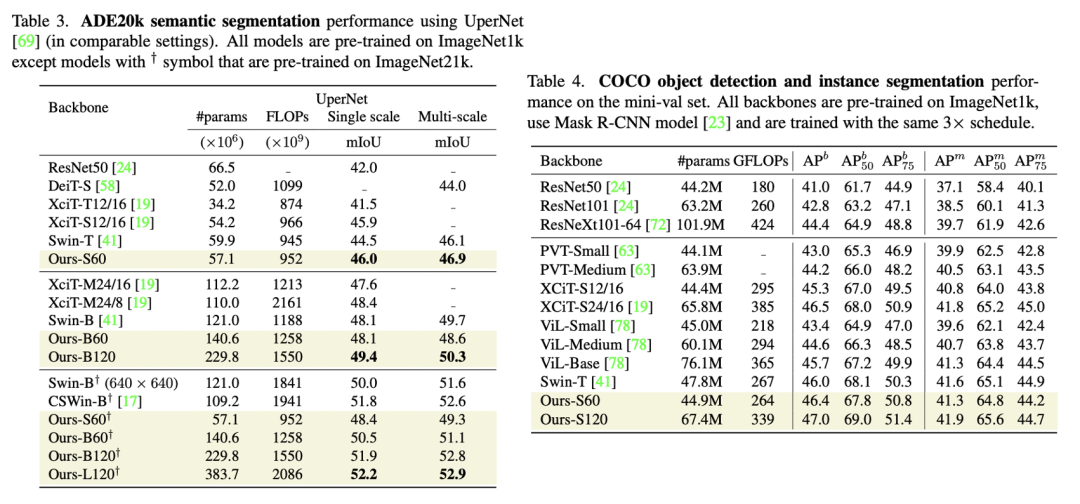 PatchConvNet的消融实验如下所示,这里是基于S60模型,可以看到对性能影响最大的是采用conv stem,如果换成linear projection,性能会下降2个点;而将LayerNorm换成BatchNorm,大约可以提升0.3个点;而如果采用简单的global average pooling,性能只掉了0.2个点,这说明attention-based pooling其实对性能影响较小,如果去掉attention-based pooling,那么PatchConvNet就真正成为一个完全的CNN了。
PatchConvNet的消融实验如下所示,这里是基于S60模型,可以看到对性能影响最大的是采用conv stem,如果换成linear projection,性能会下降2个点;而将LayerNorm换成BatchNorm,大约可以提升0.3个点;而如果采用简单的global average pooling,性能只掉了0.2个点,这说明attention-based pooling其实对性能影响较小,如果去掉attention-based pooling,那么PatchConvNet就真正成为一个完全的CNN了。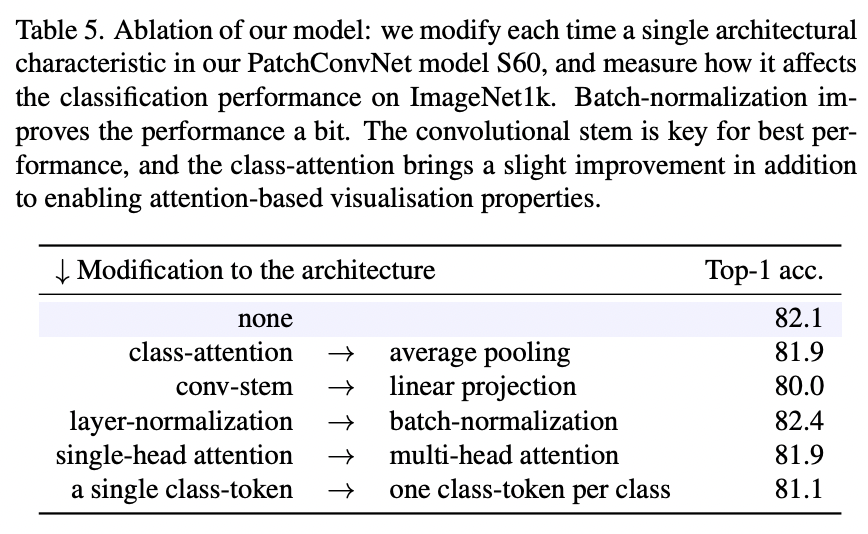 相比ConvMixer,PatchConvNet在设计上做了很多的优化比如conv stem和SE,而且PatchConvNet网络是更深,比如S60其主体就包含了180个conv layers,这也远超ResNet50和ConvMixer的层数,或许采用3x3卷积加上更深的网络能够带来弥补感受野的不足。
相比ConvMixer,PatchConvNet在设计上做了很多的优化比如conv stem和SE,而且PatchConvNet网络是更深,比如S60其主体就包含了180个conv layers,这也远超ResNet50和ConvMixer的层数,或许采用3x3卷积加上更深的网络能够带来弥补感受野的不足。
小结
本文简单介绍了最近几个基于同质架构的CNN模型,相比常用的金字塔架构,这应该算是一种改变,而且MetaAI设计的PatchConvNet也取得了较好的效果,并且可以应用在分割和检测任务上。这也让我们重新思考是否有必要采用金字塔架构,因为同质架构设计上更简单,未来金字塔架构是否被完全取代,这值得探讨。
参考
ResMLP: Feedforward networks for image classification with data-efficient training MLP-Mixer: An all-MLP Architecture for Vision Patches Are All You Need? https://github.com/facebookresearch/deit Augmenting Convolutional networks with attention-based aggregation
推荐阅读
辅助模块加速收敛,精度大幅提升!移动端实时的NanoDet-Plus来了!
机器学习算法工程师
一个用心的公众号

